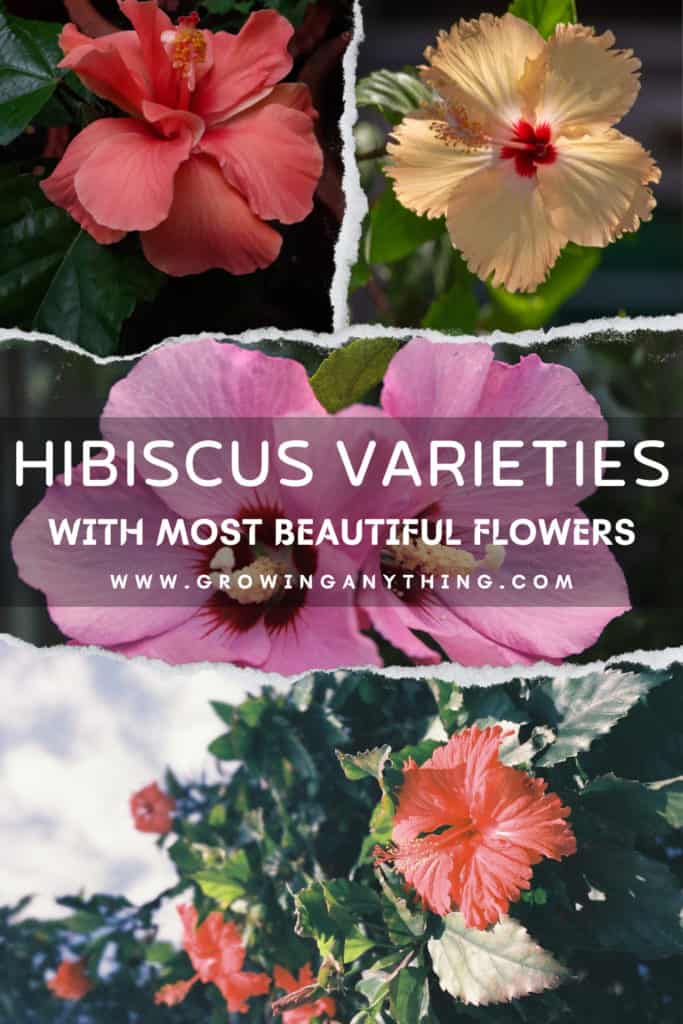38 Hibiscus Varieties
All Hibiscus varieties feature lovely flowers and are beautiful flowers to grow in your garden. If you don’t have a garden, you pick some types of Hibiscus flowers to grow in pots, indoors or outdoors.
I discuss all attractive Hibiscus types in the article. That way, you’ll become aware of the soil, sunlight, plant food, watering, and temperature conditions required for each plant.
In general, there are three major categories of Hibiscus types. The first one is hardy Hibiscus which comes back every year and survives in various conditions.
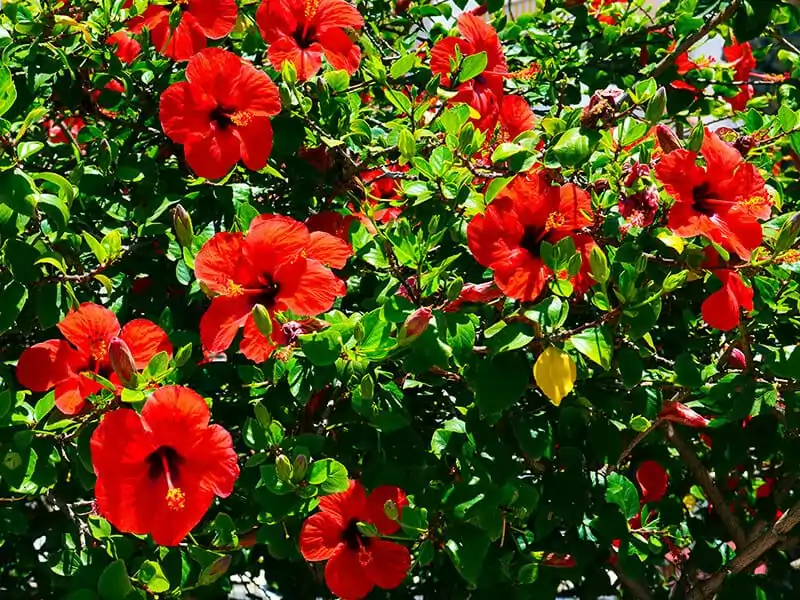
The second group, tropical Hibiscus loves the sun and doesn’t grow in colder regions. The third category, Rose of Sharon features smaller leaves and flowers but grows in extreme temperatures. Each category has varieties worth your attention!
Let’s take a look at them!
1. Rose of Sharon
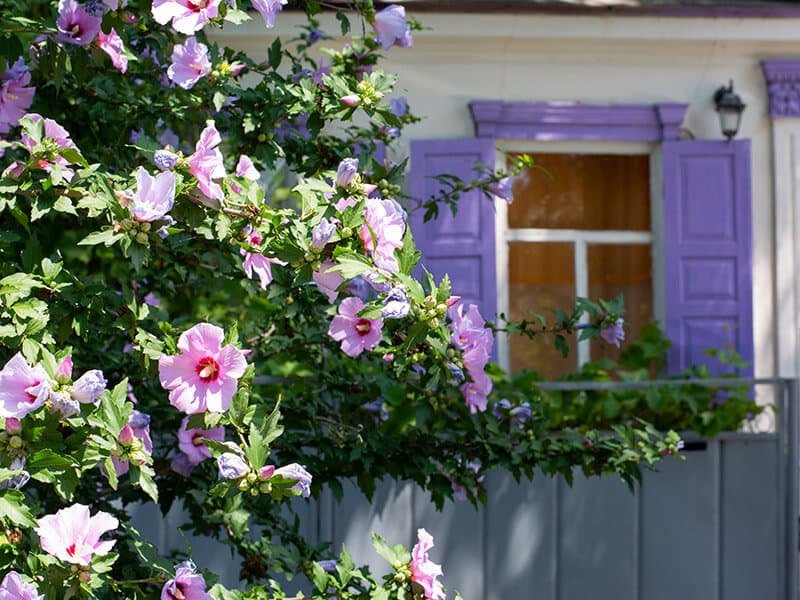
Hibiscus syriacus or Rose of Sharon is often called common Hibiscus. It is the most common Hibiscus type, and it is relatively easy to grow.
Pick a spot with excellent drainage in full sun or partial shade and plant Rose of Sharon. If you live in a colder climate, six or more sunlight hours are recommended for Rose of Sharon.
2. Flower Of An Hour
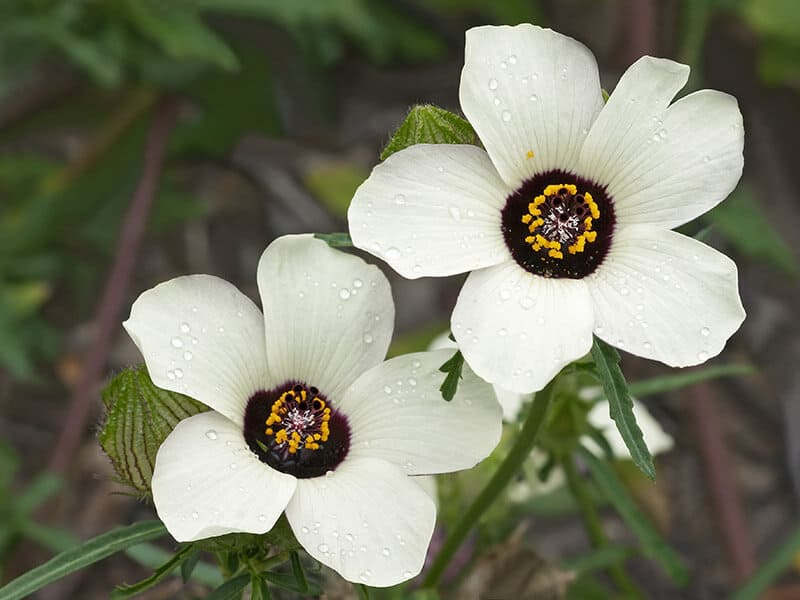
Hibiscus trionum aka Flower of an hour is a simple Hibiscus variety to grow. However, you’ll have to start a Flower of an hour from seeds, because bedding plants are rarely available. Start in the fall and be patient because Hibiscus trionum needs time to emerge.
It needs full sun and rich and moist soil to grow!
3. Giant Rose Mallow
Hibiscus Giant Rose Mallow grows best when you start seeds in the spring. It is one of the best Hibiscus varieties for northern climates.
Hibiscus Giant Rose Mallow features a fast growth rate and prefers humus-rich soil. Full sun is recommended.
4. Checkered Hibiscus
Hibiscus moscheutos or Checkered Hibiscus is a sturdy variety of Hibiscus, a vigorous grower, and a hardy plant. The flowers of Hibiscus moscheutos are large and showy, with overlapping petals and subtle fragrances.
It can adapt to light shade, but the most stunning flowers are produced in full sun locations! Protect your Hibiscus from harsh winds and water deeply in the actively growing season.
5. Cherry Cheesecake
Hibiscus Cherry Cheesecake has an average height of four feet. It features compact form, great branching, and large white flowers.
Hibiscus Cherry Cheesecake grows in the partial shade or full sare seas. This Hibiscus is almost disease and pest free, and suitable for beginners, too.
You can grow it in large pots or garden borders for a beautiful visual effect in the summer.
6. China Rose
Hibiscus rosa-sinensis or China Rose Hibiscus is only suitable for outdoor planting in freeze-free areas. If you live in a colder climate, you can grow it indoors.
China Rose Hibiscus needs a lot of sunlight and protection from harsh winds. Any garden soil will work because the plant isn’t picky about soil type and quality. However, excellent drainage is a must
You can see this video to know more:
7. Hawaiian Hibiscus
Hibiscus rosa-sinensis Hawaiian Hibiscus features huge flowers in vivid colors! It is one of the Hibiscus varieties which grows fast and blossoms early in the spring.
The blooming season of Hawaiian Hibiscus lasts through early summer, but sometimes re-blooming is possible. It has glossy foliage and looks beautiful as a patio plant.
8. Black Dragon
Hibiscus rosa-sinensis Black Dragon is a lovely Hibiscus hybrid variety. It needs a lot of moisture and plant food to develop its beautiful dark flowers. Black Dragon Hibiscus is a slow grower which requires full sun exposure to grow to its full potential.
Once it reaches its maximum height of 18 inches, this Hibiscus grows laterally.
9. Rock Hibiscus
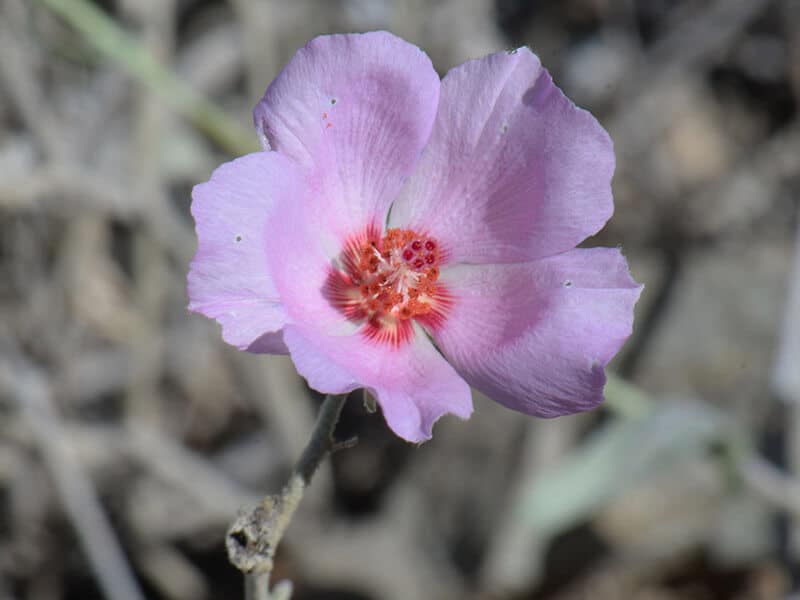
Hibiscus denudatus or Rock Hibiscus is a compact and beautiful shrub with tiny, fuzzy foliage. If the plant doesn’t get enough water, the foliage will drop.
Rock Hibiscus develops pastel lavender blooms with bright centers. It isn’t as popular and showy as other Hibiscus varieties.
10. Roselle
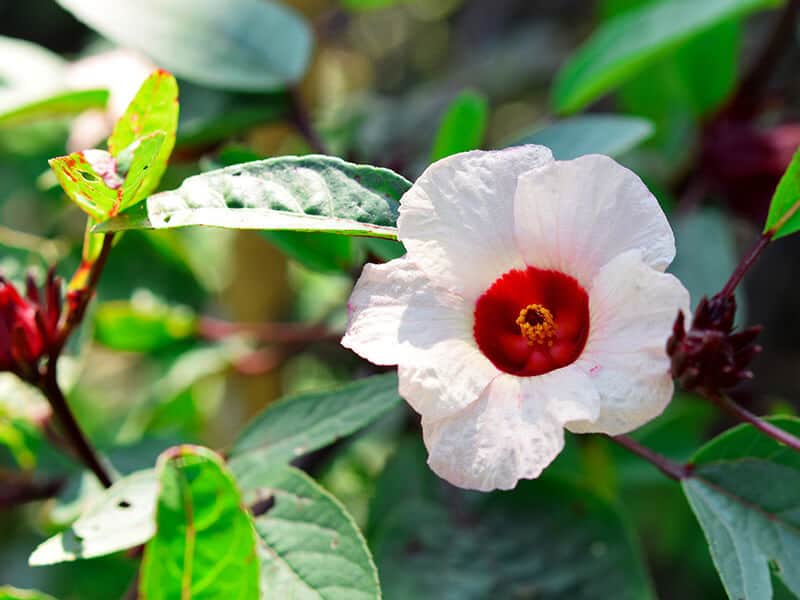
Growing Hibiscus Roselle aka Hibiscus sabdariffa is relatively easy. You can start it from seed in mid-spring or mid-summer. Pick a location with at least six hours of sunlight per day.
Wait four or six months for your Hibiscus Roselle to mature and protect the plant from freezes. You can also prune the plant to include richer branching and more blooms!
You can see this video to know more:
11. Blue Bird
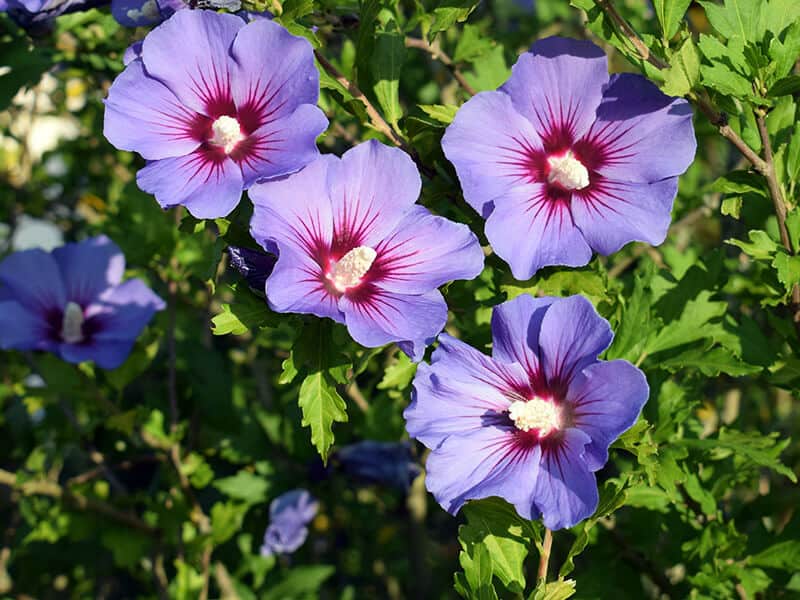
Hibiscus syriacus Blue Bird is a stunning, low-maintenance Hibiscus that will add an unusual pop of color to your garden. It grows best in neutral to slightly alkaline soil.
Blue Bird Hibiscus features rich blue flowers which last all summer long and sometimes through mid-fall. It is the perfect variety for sunny garden borders and large pots.
12. Lord Baltimore
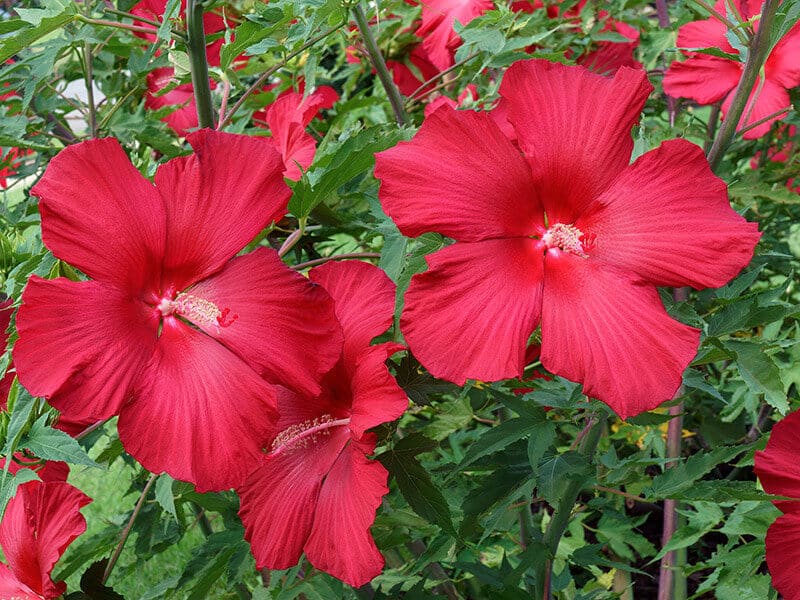
The average height of Hibiscus Lord Baltimore is between four and five feet. It is a hardy variety of Hibiscus, which can adapt to various conditions. Lord Baltimore Hibiscus prefers acidic soil but grows well in neutral.
The plant needs regular fertilization during spring and summer. Deadheading is also useful and helps your Lord Baltimore to produce a large number of flowers per season!
13. Abelmosk
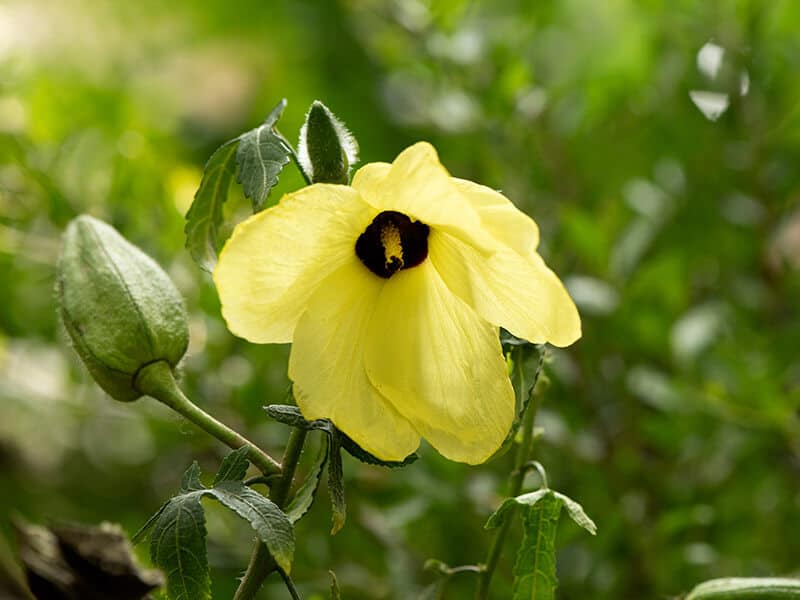
Abelmoschus moschatus or Abelmosk Hibiscus is often grown as an annual flower. It develops large and showy clumps of lemon-yellow flowers. The Abelmosk Hibiscus flowers feature dark purple centers with hairy seed pods.
This Hibiscus needs a sunny and sheltered position to develop.
14. Luna Red
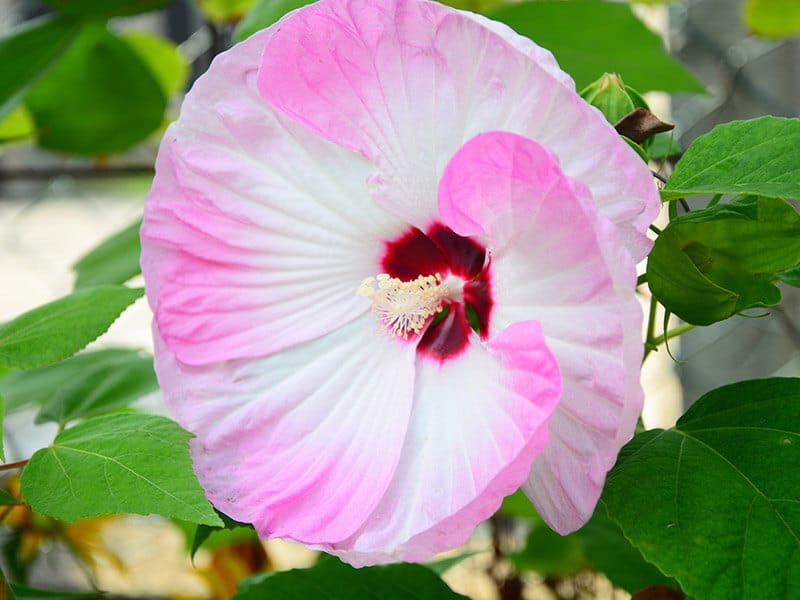
Hibiscus moscheutos Luna Red is a lovely, compact Hibiscus shrub with dark green foliage. The plant features large flowers which first develop in mid-summer.
Hibiscus Luna Red needs moist soil, sunlight, and winter protection. You can apply a layer of mulch in the winter to protect the roots from freezing and help the plant come back next spring!
You can see this video to know more:
15. Scarlet Hibiscus
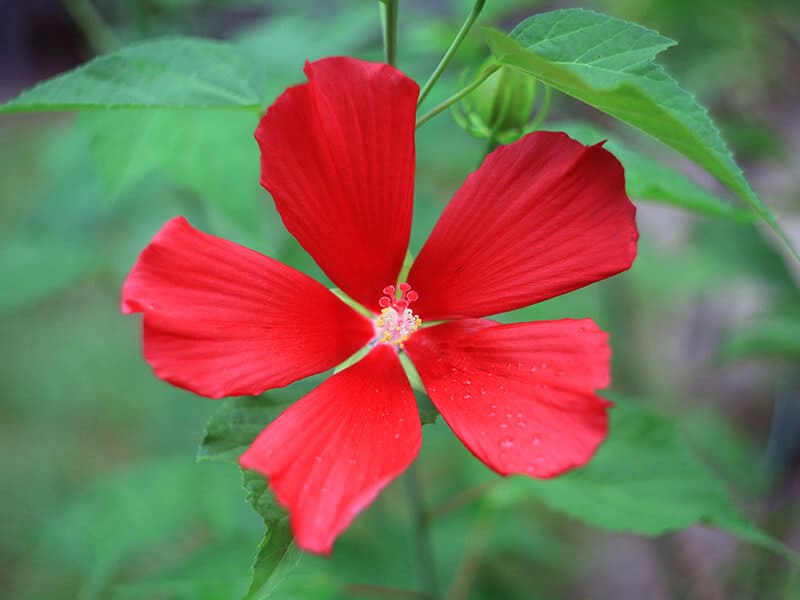
Hibiscus Coccineus or Scarlet Hibiscus can adapt to partial shade. However, if it doesn’t get enough sunlight, the flowers won’t be beautiful and Hibiscus may grow leggy.
You can grow Scarlet Hibiscus in USDA hardiness zones six and higher. It prefers warmth and high humidity.
16. Beach Beauty
Hibiscus Beach Beauty is a wonderful Hibiscus variety with 9-inch large single flowers in golden yellow. The flowers are striped with candy pink and have bright red centers.
The colorful blooms of Beach Beauty Hibiscus and low maintenance are the reasons why people love this hybrid. It has been available in nurseries since 2013.
17. Aphrodite
Hibiscus syriacus Aphrodite features gentle, ruffled pink flowers and dark green foliage. You can plant it in average, fast-draining soil with a minimum of six hours of sunlight. Aphrodite Hibiscus typically gets between eight and 12 feet tall and spreads between six and ten feet.
Aphrodite Hibiscus is deer, and pests resistant, and it is almost completely disease-free.
18. Secret Heart
The attractive Hibiscus rosa-sinensis Secret heart shrub features unusual coloration on the flowers. The centers are dark red, and the color gradually becomes bright pink through the petals’ edges.
Planting Secret heart Hibiscus in the garden is useful for many reasons. It will provide beautiful color and attract bees, hummingbirds, and butterflies to your garden. Secret heart Hibiscus can survive in 3-gallon containers or garden soil
19. Luna Pink Swirl
Hibiscus moscheutos Luna Pink Swirl requires only simple care and doesn’t have issues with disease and pests. However, the soil is soggy, and without adequate drainage, your Luna Pink Swirl Hibiscus might suffer from fungal diseases.
The flower needs deep watering twice a week during spring and summer. You should prune it to maintain the good-looking. Fertilization from spring to fall is beneficial for the Luna Pink Swirl flower.
20. Exuberance
You can recognize Hibiscus Exuberance by its large, multi-colored single flowers. The 9-inch large blooms feature various shades of orange, pink, red, and yellow.
Exuberance is a hybrid Hibiscus, developed from other vividly-colored Hibiscus types.
It grows as a medium-sized bush in full sun. You can also grow it in containers.
21. Kenaf
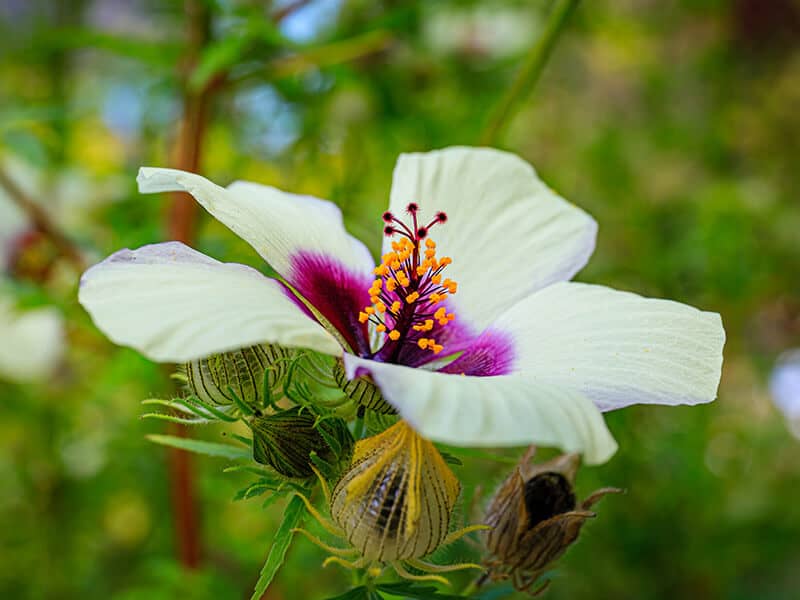
Hibiscus cannabinus or Kenaf prefers a temperature range between 59 and 80 degrees Fahrenheit. It is a sensitive Hibiscus variety that won’t develop in heavy rains or harsh winds.
On the other hand, Kenaf Hibiscus adapts to a variety of soil types. But, it prefers humus-rich soil with excellent drainage.
Kenaf is frost sensitive and cannot survive extreme cold.
You can see this video to know more:
22. Blue River II
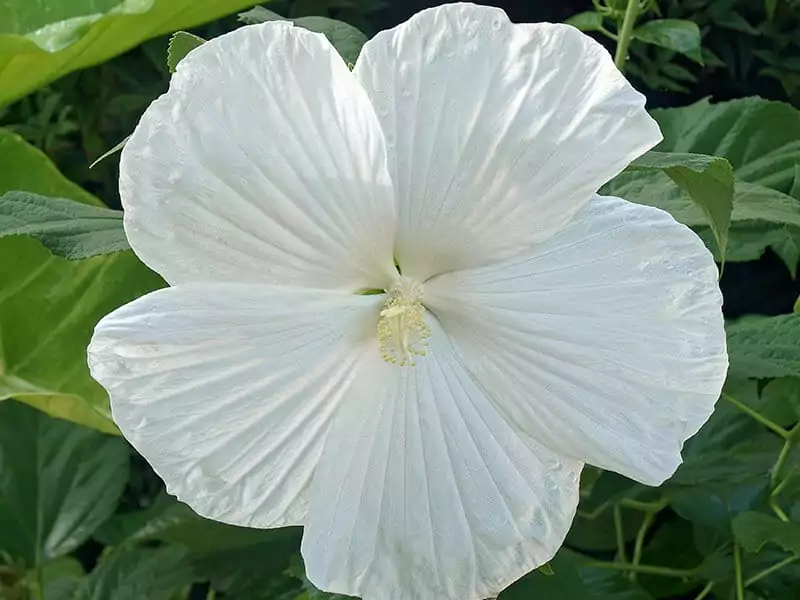
Hibiscus Blue River II features a fast growth rate and simple growing requirements. It isn’t picky about the pH value of the soil, but Hibiscus Blue River II dies in soggy soil.
This Hibiscus grows up to five feet tall and about three feet wide. Because it is tolerant of air pollution, Hibiscus Blue River II is perfect for urban gardens.
23. Sea Hibiscus
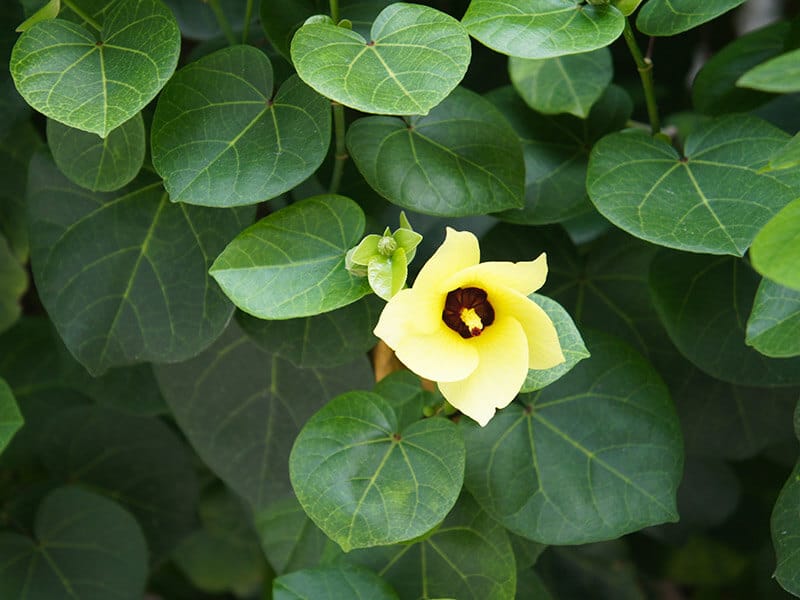
Hibiscus tiliaceus or Sea Hibiscus is a wonderful tropical plant with rich yellow flowers. It is also grown for ornamental foliage, and the leaves are glossy, dark green, and shaped like small hearts.
Sea Hibiscus needs full sun but can tolerate light shade. This Hibiscus variety cannot survive temperatures between 59 degrees Fahrenheit and is only suitable for frost-free zones. You can grow it as an annual or container plant in colder regions.
You can see this video to know more:
24. Sex On The Beach
Here is another tropical variety – Hibiscus Sex on the Beach. It features large, showy yellow-orange blowers which look stunning against dark-green foliage.
Sex on the Beach Hibiscus adds a dramatic change to any deck, patio, or garden. Ensure your plant gets between six and eight hours of direct sunlight. Plant it in airy soil and ensure plenty of water and plant food during spring and summer!
25. Mango Liqueur
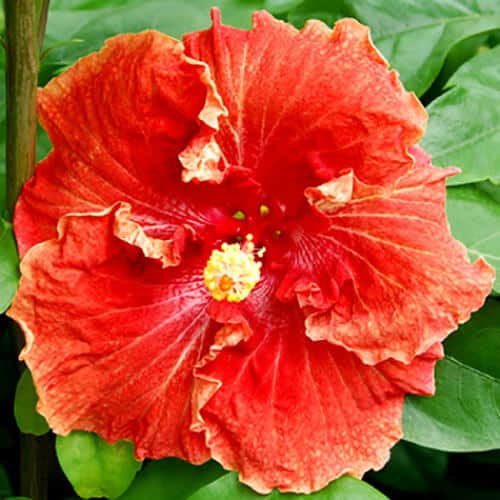
Hibiscus rosa-sinensis Mango Liqueur is a striking perennial with coral red blooms with slightly ruffled petals. You can propagate it from seeds, stems, or tips cuttings.
Mango Liqueur Hibiscus features shrub form, and you can also pick a larger container to grow it. It flowers year-round when exposed to six hours of sunlight and medium moisture.
26. Confederate Rose
Hibiscus mutabilis aka Confederate Rose is one of the most popular Hibiscus varieties ever! You can start it from seeds easily. Before you plant them, let Hibiscus mutabilis seeds dry completely. Freeze them before planting to kill any bacteria, and keep them in the fridge until you’re ready to sow them.
Choose a full sun location and fast-draining soil and enjoy eye-catching flowers in the blooming season!
You can see this video to know more:
27. Vintage Wine
The average height of Vintage Wine Hibiscus is around four feet. Usually, it blooms in pale blue, purple, and red, and it doesn’t require complex care.
Hibiscus Vintage Wine requires simple care. It grows in full sun, but can also adapt to partial shade. This Hibiscus needs medium moisture and fast-draining soil. The flower isn’t picky about soil pH but avoids sandy soil.
Don’t forget to cut the plant in spring before new growth develops.
28. Fiesta
Fiesta Hibiscus is a sun-loving plant that will develop the most beautiful flowers when exposed to eight hours of sunlight per day! Furthermore, the more sun you provide to Fiesta Hibiscus, the more attractive and numerous blooms you can expect.
But, if you live in an extremely warm and dry climate, partial shade might be beneficial for your Fiesta flower. Ensure moderate moisture and well-draining soil as well.
29. Passion
Passion Hibiscus features burgundy foliage and pink blooms. It is a fast grower that quickly gets around three feet tall and four feet wide.
Passion Hibiscus needs full sun and regular watering. In dry climates, water the plant twice per week.
Moreover, Passion Hibiscus is practical in gardens because it attracts hummingbirds, butterflies, and pollinators.
30. Seminole Pink
Seminole pink Hibiscus has dazzling pinkish blooms with rich red centers. It looks beautiful in mixed flowering beds and gardens, but you can also grow it without issues in a sunny spot on your patio, in the container.
Seminole Pink Hibiscus prefers tropical climate and is only suitable for USDA hardiness zones from nine to 11. Outside these zones, grow Seminole Pink as an annual flowering plant.
31. Bedazzled
A Hibiscus rosa-sinensis Bedazzled shrub has moderate watering needs and prefers at least six to eight hours of sunlight per day. The flowers are between six and 12 inches in diameter and orange.
Bedazzled Hibiscus attracts bees, hummingbirds, butterflies, and common insect pollinators in summer gardens. You can grow it as a single specimen plant in the garden, or containers.
32. Mars Madness
Mars Madness flower grows in moist and fast-draining soil. When you keep Mars Madness well-watered, you can expect large and showy flowers with lush leaves.
You should also deadhead the Hibiscus plant to keep it tidy and induce more flowers. I recommend planting Mars Madness flowers after frost and before the summer heat. In the first year after planting, Mars Madness needs a heavy layer of mulch in winter.
33. Nairobi
Nairobi Hibiscus contributes to the tropical landscape with its rich, multicolored blooms and lush foliage. It isn’t a popular variety of Hibiscus. But, if you prefer warm coral flowers, consider growing Nairobi in your garden.
Hibiscus Nairobi features classic, medium-sized Hibiscus blooms. The growing requirements include plenty of sunlight, moderate moisture, frequent fertilization, and regular deadheading.
34. Sugar Tip
If you are a fan of ruffled flowers, check Sugar Tip Hibiscus. The flowers are pale pink with fluffy blooms. Moreover, Sugar Tip Hibiscus is long-blooming, heat, drought, and salt tolerant.
You can grow it outside in zones from 5a to 8b without any challenges. Sugar tip Hibiscus is also one of the taller Hibiscus types, with average height, which is why you can use it as a hedge or screen.
35. Cranberry Hibiscus
Hibiscus acetosella is better known as Cranberry Hibiscus. It features dark purple centers with pale pink petals.
Cranberry Hibiscus is an adaptable plant, which can survive in partial shade. Still, the flowers are the most beautiful when your Hibiscus gets between six and eight hours of sunlight per day.
Provide the plant with ample water and excellent drainage. The ideal soil pH is between 6.1 and 6.5.
36. Berry Awesome
Berry Awesome is another attractive, adaptable Hibiscus. In ideal conditions, Berry Awesome Hibiscus develops lush foliage and huge flowers.
Plant it before extreme heat hits, and don’t forget to add a layer of mulch in the first winter.
37. Luna White
Robust and compact Luna White is recognizable by its snow-white blooms. The blooming season starts in mid-summer and lasts through fall. Interestingly, each flower only remains on the stem for a day or two. But, as soon as it dies, new flowers develop on the stem immediately.
Plant it in full sun and loose soil. Once the Luna White Hibiscus establishes, it becomes drought-tolerant.
Grow it in sunny borders, on your patio or deck.
38. Hibiscus Tricolor
Hibiscus rosa-sinensis Tricolor is a variegated Hibiscus hybrid. It is a tropical type, which needs ample sunlight, water, and plant food. Hibiscus Tricolor is often seen in city gardens because it doesn’t mind extreme air pollution.
It needs mulching in winter for root protection. The average height is three feet during maturity. Tricolor Hibiscus spreads about the same in ideal growing conditions.
Hibiscus Is Always Great Choice For Garden And Patio
Are you ready to start growing Hibiscus? I don’t know if a person can choose only one Hibiscus type to grow because there are many stunning varieties! You can find Hibiscus flowers in all shades of pink, red, orange, blue, purple, white, yellow! They are easy to mix with other garden plants and look spectacular in every corner of your space.
I am interested in growing Fiesta Hibiscus and Luna White. Which varieties caught your eye the most?
If you enjoyed the article, please hit a like button!
